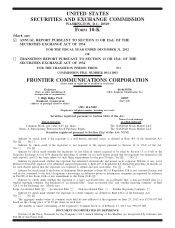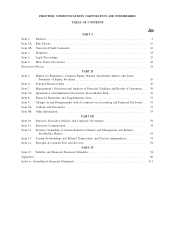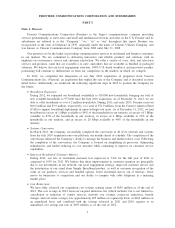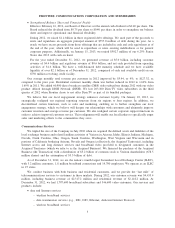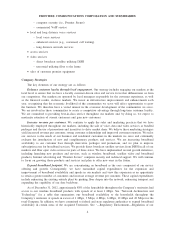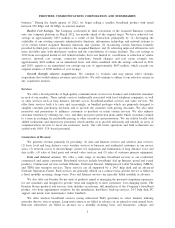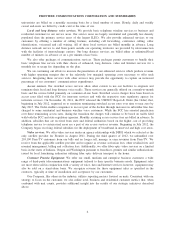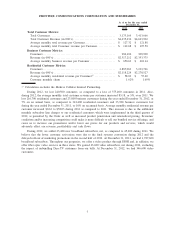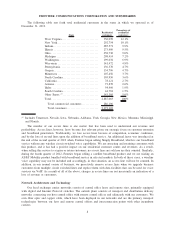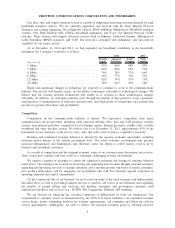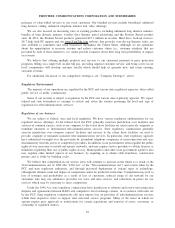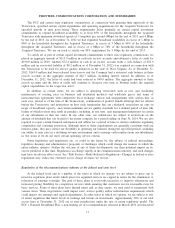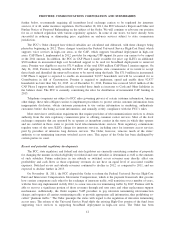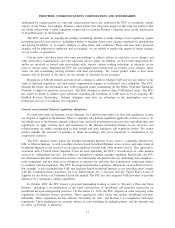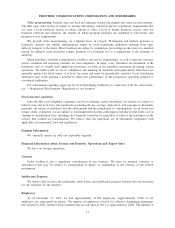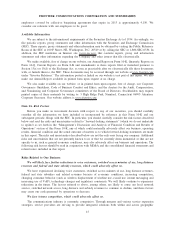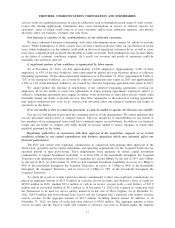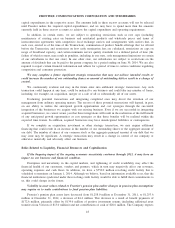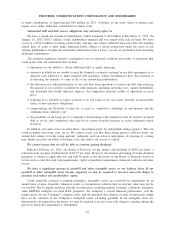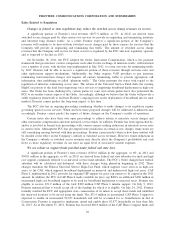Frontier Communications 2012 Annual Report Download - page 11
Download and view the complete annual report
Please find page 11 of the 2012 Frontier Communications annual report below. You can navigate through the pages in the report by either clicking on the pages listed below, or by using the keyword search tool below to find specific information within the annual report.
packages of value-added services to our voice customers. Our bundled services include broadband, unlimited
long distance calling, enhanced telephone features and video offerings.
We are also focused on increasing sales of existing products, including unlimited long distance minutes,
bundles of long distance minutes, wireless data, Internet portal advertising, and the Frontier Secure product
suite. In 2012, the Frontier Secure products generated $27.3 million in revenue. Hard drive back-up services,
24-7 help desk PC support and our www.TumTiki.com website, that provides over-the-top Internet video, are
also available to consumers and small businesses throughout the United States. Although we are optimistic
about the opportunities to increase revenue and reduce customer churn (i.e., customer attrition) that are
provided by each of these initiatives, we cannot provide assurance about their long term profitability or impact
on revenue.
We believe that offering multiple products and services to our customers pursuant to price protection
programs, billing on a single bill, on-line bill pay, providing superior customer service, and being active in our
local communities will develop customer loyalty which should help us generate new, and retain existing,
customer revenue.
For additional discussion of our competitive strategies, see “Company Strategies” above.
Regulatory Environment
The majority of our operations are regulated by the FCC and various state regulatory agencies, often called
public service or utility commissions.
Some of our revenue is subject to regulation by the FCC and various state regulatory agencies. We expect
federal and state lawmakers to continue to review and revise the statutes governing the level and type of
regulation for telecommunications services.
Regulation of our business
We are subject to federal, state and local regulation. We have various regulatory authorizations for our
regulated service offerings. At the federal level, the FCC generally exercises jurisdiction over facilities and
services of common carriers, such as our company, to the extent those facilities are used to provide, originate or
terminate interstate or international telecommunications services. State regulatory commissions generally
exercise jurisdiction over common carriers’ facilities and services to the extent those facilities are used to
provide, originate or terminate intrastate telecommunications services. In particular, state regulatory agencies
have substantial oversight over the provision by incumbent telephone companies of interconnection and non-
discriminatory network access to competitive providers. In addition, local governments often regulate the public
rights-of-way necessary to install and operate networks, and may require service providers to obtain licenses or
franchises regulating their use of public rights-of-way. Municipalities and other local government agencies also
may regulate other limited aspects of our business, by requiring us to obtain cable franchises, construction
permits and to abide by building codes.
We believe that competition in our service areas will continue to increase in the future as a result of the
Telecommunications Act of 1996 (the “1996 Act” or the “Telecommunications Act”) and actions taken by the
FCC and state regulatory authorities, and through increased deployment of various types of technology,
although the ultimate form and degree of competition cannot be predicted at this time. Competition may lead to
loss of revenues and profitability as a result of loss of customers; reduced usage of our network by our
customers who may use alternative providers for voice and data services; and reductions in prices for our
services which may be necessary to meet competition.
Under the 1996 Act, state regulatory commissions have jurisdiction to arbitrate and review interconnection
disputes and agreements between ILECs and competitive local exchange carriers, in accordance with rules set
by the FCC. State regulatory commissions also may impose fees on providers of telecommunications services
within their respective states to support state universal service programs. Many of the states in which we
operate require prior approvals or notifications for certain acquisitions and transfers of assets, customers, or
ownership of regulated entities.
10
FRONTIER COMMUNICATIONS CORPORATION AND SUBSIDIARIES

